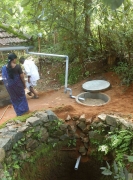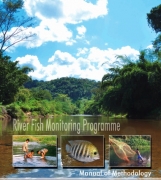Kerala
Kerala state disaster management policy - Kerala State Disaster Management Authority (2009)
Posted on 11 Oct, 2010 04:28 PMThis document highlights the vulnerable status of the state in terms of natural disasters and highlights the urgent need for a disaster management strategy for the state.
The objectives of the Kerala state disaster management policy include:
- To develop and ensure policy, institutional and techno – legal frameworks for disaster management in the state
- To develop and maintain proactive governance and systems, and promote research and development for Disaster risk management strategies for disaster prevention and mitigation.
- To establish effective disaster crisis management through the organisation and management of resources and responsibilities for dealing with all aspects of emergencies with respect to response, rehabilitation and reconstruction.
- To strengthen the capacities and resilience of vulnerable communities with special emphasis on empowerment of women and establish community level systems for pre, during and post disaster interventions.
- To build capacities and promote positive changes in the administrative systems, procedures and personnel that would facilitate efficient and effective pre and post disaster activities.
- To institutionalise disaster management in government as envisaged in DM Act, 2005 and to mainstream disaster management in to developmental planning.
7th International Conference on ‘Reaching Out to People: Achieving Millennium Development Goals through Innovative Public Service Delivery', NAPSIPAG, Trivandrum
Posted on 11 Oct, 2010 11:59 AMInnovations in public service delivery systems to achieve the Millennium Development Goals (MDGs) by the year 2015

The First Indian Biodiversity Congress (IBC) 2010, CISSA, Thiruvananthapuram
Posted on 01 Oct, 2010 02:04 PMIndian Biodiversity Congress (IBC) 2010
Theme: Biodiversity and Development: Mainstreaming Biodiversity into Policy-Making
Field experiences by Avinash Krishnamurthy, BIOME Solutions
Posted on 29 Sep, 2010 11:04 AMOne of the oldest "People's electricity" systems I have ever seen (Please read the notes for each of the videos). Of course this trip had even better high points - wine made from Gooseberry and Nutmeg - all locally brewed. So travelling in the midst of hills, sipping local wine, seeing some great work, (and providing perspectives for someone-else to write - is this work or what?
Appeal to save Ramsar site - Kol wetland, Kerala
Posted on 17 Aug, 2010 03:28 PMAmayam island in Kololambu, Edappal panchayath, Malappuram ditstrict, Kerala state which have rich in biodiversity and 40 acres of kol wet land is around the island is also rich in its rare biodiversity. This kol wet land is a part of vembanad backwaters (13,632 hectors) and declared as RAMSAR SITE (No. 1214) in 2002.
Investigation of the capability of Artificial Neural Network technique for estimating evapotranspiration from minimum weather data of Tavanur, Kerala – A research report by National Institute of Hydrology
Posted on 28 Jul, 2010 07:50 PMThe study attempted to estimate the actual crop evapotranspiration from minimum weather data of Tavanur, Kerala and resulted in an Artificial Neural Network (ANN) model, which makes use of average temperature data to estimate the actual evapotranspiration. The effectiveness of this model was evaluated using various statistical indices. The results of this model were compared with various existing techniques. The analysis led to the conclusion that the ANN models were performing better than all existing techniques for computing the actual evapotranspiration. However, the study was based on a single season lysimeter data and more research work may be required to reinforce this conclusion.
Modeling of Cochin estuary using two dimensional finite element model – A research report by National Institute of Hydrology
Posted on 27 Jul, 2010 08:07 PMThe report deals with the modeling of the Cochin estuary along Kerala coast using two- dimensional finite element model. The basic equations for modeling of any surface water problems are the three dimensional hydrodynamic equations arising from consideration of mass and momentum conservation. In vertically well mixed shallow water bodies, the horizontal components of flow quantities are normally much more significant than vertical components.
Seeds of hope - Case studies from the Planning Commission and Lokayan
Posted on 12 Jul, 2010 03:33 AMThis set of case studies is part of a book prepared by Lokayan in collaboration with the Planning Commission titled “Seeds of Hope", covers themes of agricultur
Mazhapolima Participatory Well Recharge Programme - Concept Note and Process Document (2009)
Posted on 07 Jun, 2010 07:27 PM Mazhapolima is a community based well recharge programme, initiated by the Thrissur District Administration in collaboration with the Panchayat Raj Institutions in the District, and implemented by networking NGOs/CBOs, households, departments and agencies, research institutions, private sector and all other key stakeholders, who are either a water user or a water provider/planner.
Mazhapolima is a community based well recharge programme, initiated by the Thrissur District Administration in collaboration with the Panchayat Raj Institutions in the District, and implemented by networking NGOs/CBOs, households, departments and agencies, research institutions, private sector and all other key stakeholders, who are either a water user or a water provider/planner.
Diversity of approaches and implementation arrangements according to location specific needs centered on sustainable outcome and service levels are the underlying tenets of the programme. The programme envisages recharging of about 4.5 lakh open wells in the district to ensure sustainable access to water.
River Fish Monitoring Programme - Manual of Methodology by Kerala State Biodiversity Board
Posted on 07 Jun, 2010 03:33 PM Measurement of riverine biota, particularly benthic macroinvertebrates (such as crustaceans and aquatic insects) and fish, has become a widely accepted method of identifying the structural or functional integrity and the overall health of a riverine system. This manual from the Kerala State Biodiversity Board (KSBB), describes in detail the field procedures to be followed in such fish monitoring/measurement surveys, conducted for riverine ecological systems.
Measurement of riverine biota, particularly benthic macroinvertebrates (such as crustaceans and aquatic insects) and fish, has become a widely accepted method of identifying the structural or functional integrity and the overall health of a riverine system. This manual from the Kerala State Biodiversity Board (KSBB), describes in detail the field procedures to be followed in such fish monitoring/measurement surveys, conducted for riverine ecological systems.
KSBB has taken up this manual publication effort, in the conxtet of a state-wide fish monitoring programme, that aims to survey all the 44 rivers of Kerala with the involvement of resource persons from local colleges, research institutes, experts and fisherpeople community.